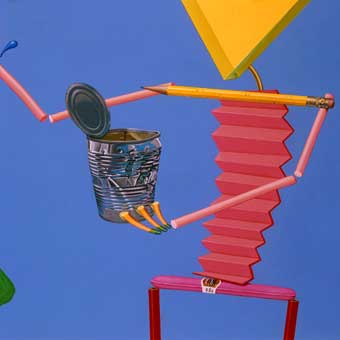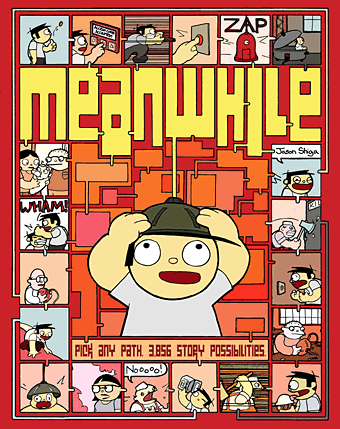Look Familiar?

No big news today, so here’s a random slice from a random recent photo I took. Look familiar?
I’d say about 1 in 40 of you should recognize the above image right away. As for the rest, um… I guess I just think it looks cool.

No big news today, so here’s a random slice from a random recent photo I took. Look familiar?
I’d say about 1 in 40 of you should recognize the above image right away. As for the rest, um… I guess I just think it looks cool.
I get the Graphic NYC treatment!: interviewed by Christopher Irving and photographed by Seth Kushner during my reference-taking mission in January.
Seth and Christopher were great hosts and also shared their impressions of Brooklyn with me. It was a pleasure speaking with and providing a subject for both of these talented thinkers.
 Another quick trip. This time to Liverpool for an in-house thingey at SCE. Back in a couple of days.
Another quick trip. This time to Liverpool for an in-house thingey at SCE. Back in a couple of days.
Here’s a lovely drawing by Vera Brosgol from several years ago:
And here’s a t-shirt recently offered by the band Pierce the Veil on Hot Topic’s website without Vera’s knowledge or consent:

Think this sort of thing doesn’t happen that often? Think again.
[UPDATE: Vera tweeted that both Hot Topic and the band have pulled the shirt and apologized, so rather than angry emails, let’s congratulate them for doing the right thing. As for the designer…]
 Quick note that I’m on the road to Philadelphia for a talk to students at the Germantown Friends School and William Penn Charter School.
Quick note that I’m on the road to Philadelphia for a talk to students at the Germantown Friends School and William Penn Charter School.
Not public talks, I’m afraid, but I’m sure I’ll be back in Philly before too long (my last visit was 2006’s talk at Drexel University).
As usual, blogging might take a break until I’m back on Friday. Enjoy the week!
 Zahra’s Paradise is a new comic being offered online by First Second. From what we’ve seen, it promises to be an absorbing true story and I like the art. It’s being released simultaneously in English, Farsi, Arabic, French, Spanish, Italian, Dutchs—seven languages in all. Eight, if you count the language of comics.
Zahra’s Paradise is a new comic being offered online by First Second. From what we’ve seen, it promises to be an absorbing true story and I like the art. It’s being released simultaneously in English, Farsi, Arabic, French, Spanish, Italian, Dutchs—seven languages in all. Eight, if you count the language of comics.
Zahra’s release follows closely on the heels of Valentine, released in a whopping twelve languages simultaneously. If this is a trend, I like it.
[Edit to add: In the original post, I’d referred to Valentine as “Robot Comics’ Valentine”—it’s actually available from Robot Comics, Comixology, Ave! Comics in France, and others soon. Needless to say, the multiple publishers aspect may be even more important in the long run if that trend also continues. Oh, and they’re already up to 14 languages.]

Understanding Comics has been translated over the years into 16 languages, but like any book project, the process of getting it printed and distributed from scratch in each country requires an enormous amount of effort for its respective publishers.
The idea that all these dammed-up rivers of art and story might start breaking free all over the world soon is encouraging.
 Yesterday’s trip to the post office box brought a welcome surprise: a great collection of paintings by Kathy Calderwood, one of my art teachers at Syracuse University thirty years ago.
Yesterday’s trip to the post office box brought a welcome surprise: a great collection of paintings by Kathy Calderwood, one of my art teachers at Syracuse University thirty years ago.
Kathy was one of the cool teachers at S.U., who enjoyed cartoon iconography and didn’t discriminate against “low” arts like comics. Others included Larry Bakke who drew from nearly every discipline in his aethetics lectures, and Murray Tinkelman, who had a Krazy Kat original and was tennis partners with Will Eisner.
I was always grateful, in retrospect, that the faculty at Syracuse were as open to comics as they were. Positive attitudes about comics weren’t nearly as common then as they are now.
For all the encouragement I got for my comics, though, I always figured I was at Syracuse to learn everything else. There were things I learned during classes in poetry, music appreciation, theater, and animation that I still use today. Making comics requires so many skills and areas of knowledge, hardly anything I learned was ever really wasted.
In junior year something clicked. I started auditing classes and going to the library more and visiting local museums. I realized that no one was going to be grading me past the age of 22 and no one could ever be as invested in my progress as I was. I was learning how to learn.
Thanks to all my teachers from kindergarten onward, who helped me get to that point.

Why is nearly every ice bag in nearly every ice bucket in nearly every hotel in America too small for the bucket??
Why do Zuda’s webcomics blur needlessly between pages??
Why is it so hard to find black bottled ice tea without any kind of sweetener in it?? (Especially in NYC)
Why is it so hard to find official confirmation (instead of just message board chatter) on whether uncooked French green beans are really toxic or not (something I hadn’t even heard of until recently, but is apparently a “well known fact” in Europe—WTF??).
How can the employees at my local UPS office watch as people go in the wrong door due to the bad signage, day after day, month after month, year after year, FOR TEN YEARS yet never think to change the signs??
(Okay, that’s not something anyone can answer, but I had to get it out of my system).
Why are some people so passionately devoted to the movie Apollo 13? I mean, it’s a perfectly competent movie, and the box of junk scene is awesome, but what’s the big deal??
Why did it take centuries for people to realize they could put wheels on suitcases?? Is there another super-obvious design solution that we’re overlooking??
 This book is going to be so, so, cool!
This book is going to be so, so, cool!
Many of us cartoonists already own Jason Shiga‘s original hand-printed version of this insane choose-own-adventure masterpiece (he even has a quote from me), but the idea of a full-out professionally printed version with tabs. Ah, be still my heart…
Best of all is the absolute certainty that whenever we see the number “3,856” used to describe the many branching possibilities, it was Shiga himself that came up with the number and the number’s gonna be correct.
 In looking over this travesty, keep in mind that the “crime” in question is essentially a Thought Crime with no victims, and that the man going to jail is doing so for a small fraction of the comics in his collection. If these sorts of victimless crimes sound insane to you as they do to me and my family, please consider a donation to help fight such cases in the future.
In looking over this travesty, keep in mind that the “crime” in question is essentially a Thought Crime with no victims, and that the man going to jail is doing so for a small fraction of the comics in his collection. If these sorts of victimless crimes sound insane to you as they do to me and my family, please consider a donation to help fight such cases in the future.
***
In happier news, I notice today’s Google Doodle (Feb 16) is Curling! Since Ivy’s curling these days, I’m giving a shout-out to a great sport that’s finally living large in a country that appreciates it. You can bet we’ll be watching whatever meager coverage it gets here in the States.
***
Meanwhile, this post about hand strain (via Dirk) gives me an opportunity to share some tips that I’ve found useful for avoiding hand strain.
1. Fatten your grip. A simple, easy way to reduce hand strain is to widen the radius of the tools you use most often. Above left is a shot of my big fat Cintiq pen, courtesy of some masking and packing tape. Ugly as hell, but just as easy to use and less likely to freak out my tendons.
2. Feet on the Floor. Seriously, your whole body relaxes when your feet are flat on the floor. If necessary get one of those raised foot rests. I was surprised how well this worked, but it really did.
3. Drawing big. If you’re all digital like me, zooming in can help make most drawing tasks a matter of forearm movement rather than wrist movement, which makes a big difference.
4. Use your breaks. When I was having problems and was taking breaks of five minutes for every twenty, I used a timer and took it as an opportunity to catch up on some reading. It was actually kind of fun to have to read about an hour more each day.
5. See a Pro. If you ever get the tingles, see someone right away. There are specialists who can help and save you a lot of money in the long run.
And of course there’s a ton of information online as usual. Click around to learn more (at least until the clicking starts to hurt).